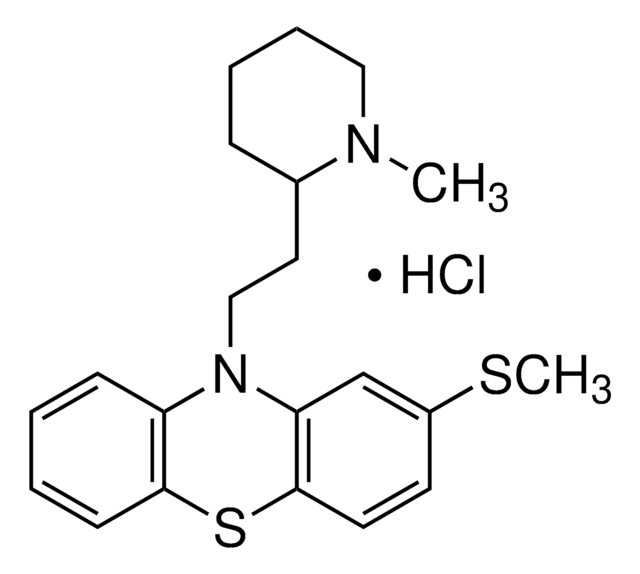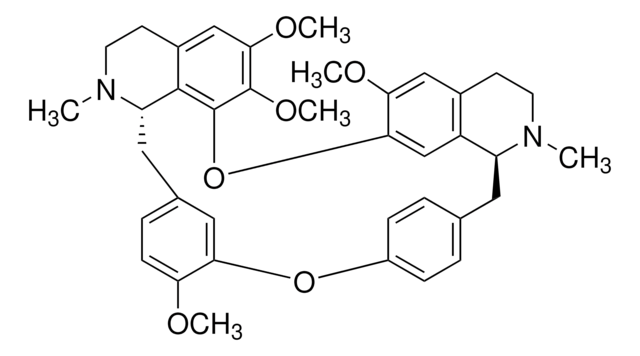T-905
Thioridazine solution
1.0 mg/mL in methanol, ampule of 1 mL, certified reference material, Cerilliant®
About This Item
Recommended Products
grade
certified reference material
form
liquid
feature
Snap-N-Spike®/Snap-N-Shoot®
packaging
ampule of 1 mL
manufacturer/tradename
Cerilliant®
concentration
1.0 mg/mL in methanol
technique(s)
gas chromatography (GC): suitable
liquid chromatography (LC): suitable
application(s)
clinical testing
format
single component solution
storage temp.
−20°C
SMILES string
CSc1ccc2Sc3ccccc3N(CCC4CCCCN4C)c2c1
InChI
1S/C21H26N2S2/c1-22-13-6-5-7-16(22)12-14-23-18-8-3-4-9-20(18)25-21-11-10-17(24-2)15-19(21)23/h3-4,8-11,15-16H,5-7,12-14H2,1-2H3
InChI key
KLBQZWRITKRQQV-UHFFFAOYSA-N
Gene Information
human ... DRD2(1813) , DRD3(1814) , DRD4(1815) , HTR2A(3356) , HTR2C(3358)
General description
Application
- Fluorescence Chemosensor Development: Thioridazine solution has been utilized in the synthesis and application of an aldazine-based fluorescence chemosensor. This innovation allows for the sequential detection of Cu²⁺ and biological thiols in aqueous solutions and living cells, enhancing analytical capabilities in biochemical and medical research (Jia et al., 2016).
- Voltammetric Analysis Enhancement: Research involving thioridazine solution has led to the development of a modified glassy carbon electrode with immobilized cobalt nanoparticles. This advancement facilitates the sensitive voltammetric determination of thioridazine, improving detection methods in pharmaceutical and clinical settings (Shahrokhian et al., 2009).
- Microencapsulation Techniques: Thioridazine has been applied in pioneering work on the microencapsulation of drugs using gold nanoparticles. This technique aims to enhance drug delivery systems by improving the bioavailability and controlled release of antipsychotic medications, offering significant benefits for long-term psychiatric treatment (Lai et al., 2006).
Legal Information
related product
Signal Word
Danger
Hazard Statements
Precautionary Statements
Hazard Classifications
Acute Tox. 3 Dermal - Acute Tox. 3 Inhalation - Acute Tox. 3 Oral - Flam. Liq. 2 - STOT SE 1
Target Organs
Eyes,Central nervous system
Storage Class Code
3 - Flammable liquids
WGK
WGK 2
Flash Point(F)
49.5 °F - closed cup
Flash Point(C)
9.7 °C - closed cup
Regulatory Listings
Regulatory Listings are mainly provided for chemical products. Only limited information can be provided here for non-chemical products. No entry means none of the components are listed. It is the user’s obligation to ensure the safe and legal use of the product.
FSL
Group 4: Flammable liquids
Alcohols
Hazardous rank II
ISHL Indicated Name
Substances Subject to be Indicated Names
ISHL Notified Names
Substances Subject to be Notified Names
JAN Code
T-905-CC:
T-905-1ML:4548173917597
Certificates of Analysis (COA)
Search for Certificates of Analysis (COA) by entering the products Lot/Batch Number. Lot and Batch Numbers can be found on a product’s label following the words ‘Lot’ or ‘Batch’.
Already Own This Product?
Find documentation for the products that you have recently purchased in the Document Library.
Our team of scientists has experience in all areas of research including Life Science, Material Science, Chemical Synthesis, Chromatography, Analytical and many others.
Contact Technical Service











